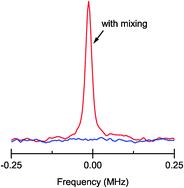Over the years, several strategies have been developed for generating highly polarized nuclear spin systems, including dynamic nuclear polarization, optical pumping, and methods exploiting parahydrogen. Here, we present an alternative strategy, using an enhanced ‘brute-force’ approach (i.e. exposure to low temperatures and high applied magnetic fields). The main problem with this approach is that it may take an excessively long time for the nuclear polarization to approach thermal equilibrium at low temperatures, since nuclear relaxation becomes exceedingly slow due to the loss of molecular motion. We show that low-field thermal mixing can alleviate the problem by increasing the rate at which slowly-relaxing nuclei reach equilibrium. More specifically, we show that polarization can be transferred from a relatively rapidly relaxing 1H reservoir to more slowly relaxing 13C and 31P nuclei. The effects are particularly dramatic for the 31P nuclei, which in experiments at a temperature of 4.2 K and a field of 2 T show a 75-fold enhancement in their effective rate of approach to equilibrium, and an even greater (150-fold) enhancement in the presence of a relaxation agent. The mixing step is also very effective in terms of the amount of polarization transferred—70–90% of the maximum theoretical value in the experiments reported here. These findings have important implications for brute-force polarization, for the problem becomes one of how to relax the solvent protons rather than individual more slowly-relaxing nuclei of interest. This should be a much more tractable proposition, and offers the additional attraction that a wide range of nuclear species can be polarized simultaneously. We further show that the 1H reservoir can be tapped repeatedly through a number of consecutive thermal mixing steps, and that this could provide additional sensitivity enhancement in solid-state NMR.

You have access to this article
 Please wait while we load your content...
Something went wrong. Try again?
Please wait while we load your content...
Something went wrong. Try again?


 Please wait while we load your content...
Please wait while we load your content...